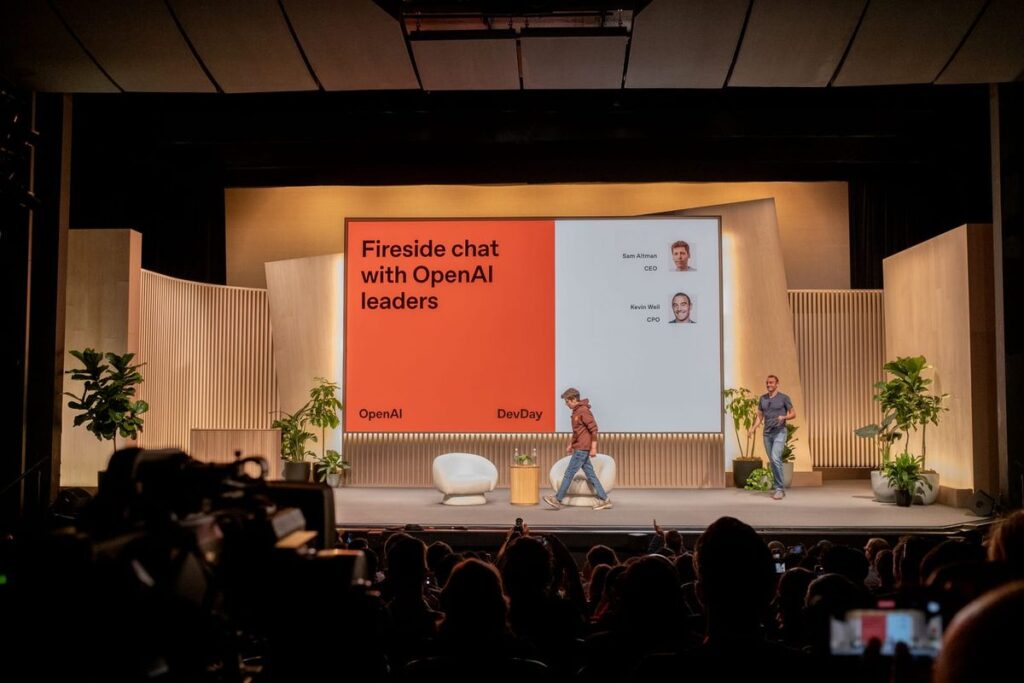OpenAI’s DevDay 2025 isn’t just another tech reveal — it sends a message to enterprises: generative AI is evolving rapidly, and merely using ChatGPT or calling models via API isn’t enough. To succeed, organizations must become AI Builders—capable of integrating, governing, scaling, and embedding AI into their core operations.
In this article, we’ll explore what enterprises must internalize from DevDay, the challenges they’ll face, and how DXTech helps bridge the gap from vision to production-grade AI systems.
The Shift: ChatGPT as Launchpad, Not Endgame
During DevDay, OpenAI showcased how ChatGPT is becoming more than a conversational assistant — it’s becoming a platform. With Apps in ChatGPT, a new AgentKit, and the release of GPT-5 Pro, they demonstrated that ChatGPT is the launching point for more sophisticated AI workflows and integrations.

For enterprises, this means:
- ChatGPT is no longer the endpoint; it becomes a core interface into broader systems.
- AI must connect back into enterprise systems (CRM, ERP, HR, finance) rather than remain isolated.
- The boundary between “AI tool” and “business capability” blurs: every AI component must serve enterprise goals, not just novelty.
Thus, firms must pivot from adopting AI tools toward building AI ecosystems.
Lessons for Enterprises: What DevDay Reveals
1. Integration is more critical than raw capability
The real power of DevDay announcements lies not in the raw capabilities (models, agents) but in how they integrate. Whether embedding an app in ChatGPT or orchestrating agent logic across workflows, the enterprise that can weave AI into its systems wins.
But enterprises often struggle here: legacy systems, fragmented data, rigid architectures. A survey from IBM shows 1 in 3 IT professionals cite data complexity and silos as top obstacles to AI deployment.
DXTech’s role: create bridges (APIs, modular frameworks, data pipelines) so that GPT-based capabilities don’t remain islands.
2. Governance & trust can’t be an afterthought
With agents, embedded apps, and deeper AI integration, risk increases: accuracy drift, bias, compliance violations, lack of explainability. DevDay’s governance and monitoring tools hint at this need.
Enterprises must embed governance from day one, not as a bolt-on. Key practices:
- Explainability modules
- Logs / decision traceability
- Human-in-loop gates
- Automated drift detection
- Role-based controls
DXTech ensures these controls travel with every AI deployment — not just the model.
3. Talent & mindset is the real bottleneck
The technology is advancing fast — but organizations lag because of skills, culture, and process. According to a BCG/BCG-style study, 74% of companies struggle to get measurable value from AI programs. IBM also reports that 42% of organizations see lack of deep domain data / model customization skills as a barrier.
Becoming an AI Builder requires cross-disciplinary talent: AI engineers, domain experts, product owners, governance specialists. Enterprises must commit to reskilling and cultural change.
4. It’s about sustained value, not hype
Many AI projects stall after proof-of-concept due to unclear ROI or lack of alignment with business outcomes. CIO Dive noted that enterprises struggle to quantify business value from AI pilots.
DevDay reminds us: powerful capabilities are only useful when paired with business metrics. AI Builders must design for outcomes: cost savings, customer retention, process time reduction.
How DXTech Helps Enterprises Transition from AI Users → AI Builders
At DXTech, we don’t deliver disconnected models — we build AI systems that align with enterprise scale, risk, and legacy.
Here’s how we help clients become genuine AI Builders:
- Architectural scaffolding: modular, layered AI frameworks so new components (e.g. agents, apps) plug in without rework.
- Governance baked-in: we deliver monitoring, audit trails, bias controls, compliance frameworks as part of the system.
- Domain bridging: we calibrate GPT and agent capabilities using domain data (finance, public sector, operations) so outputs are reliable and actionable.
- Phased deployment: pilots with rollback, canary paths, human oversight, gradual scaling — reducing risk.
- Change enablement: training, co-creation with business users, feedback loops that evolve the system rather than leave it stagnant.
The result: AI that doesn’t live in a lab, but lives in the operations, with measurable impact.
Challenges & Considerations
No transformation is easy. Enterprises will need to manage:
- Technical debt: ensuring new AI layers don’t exacerbate fragile architectures.
- Data readiness: cleaning, labeling, integrating enterprise data into models.
- Governance conflicts: balancing agility and control, especially across departments.
- Vendor alignment: choosing AI partners that support extensibility, not lock-in.
But the risk of inaction is higher: organizations that treat AI as a tool will fall behind those that build AI infrastructure.
The Rise of Enterprise AI Builders
DevDay 2025 signals a shift: AI is not just a service you consume, but a system you must build. For enterprises, the question becomes: will we be users of AI or architects of AI?
DXTech sees itself, and its clients, on the builder side of that divide. We help translate the excitement of DevDay into grounded, scalable systems — shifting enterprises from experimentation to architecture, from tools to platforms.
Let’s build AI ecosystems, not just AI features.